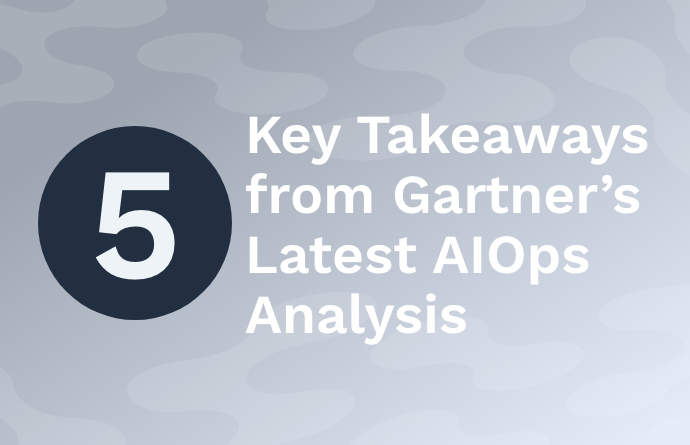If you’re still unpacking the latest terminology from Gartner’s 2023 AIOps market update, you aren’t alone. Subject matter experts from Moogsoft recently joined thought leaders from TIAA and Windward Consulting for a debrief on the panel interview Accelerating Your AIOps Journey Webinar. Almost half of technology leaders looking to improve productivity and fuel greater collaboration are struggling to explain AIOps use cases, benefits, and value to other business leaders.
And now there is new Gartner AIOps terminology to navigate. This blog will give you a Cliff Notes version while highlighting some of the big takeaways from our expert AIOps panel, so you can gain insights on the latest Gartner research and more clarity around the value of AIOps and regular use cases.
Let’s explore some of the topics from Gartner’s latest AIOps findings, and how some experts are responding:
1. Don’t get confused by the new AIOps terminology.
After a constant drumbeat dialogue about domain-agnostic versus domain-centric, (point solution monitoring) AIOps last year, Gartner is now breaking AIOps solutions into three categories:
- Data and Analytics
- AIOps Features
- AIOps Platforms
“Nothing changed in the markets in terms of what these products do. This is just a different way of helping people understand where the vendor offerings fit into this space,” explains Phil Tee, Moogsoft founder. He describes the fresh categories as an artificial ontology and translates the new slang into the following.
Data and Analytics: This is a large-log analytics-like platform you leverage combined with Pythonesque libraries to build something that looks like AI on top of that framework. These vendor(s) are minimal in the space and weren’t included in Gartner’s AIOps market findings previously because they aren’t true AI-powered solutions.
AIOps Features: These are the point-solution-monitoring platforms that Gartner previously labeled Domain Centric AIOps—accounting for a large chunk of available AIOps technologies.
AIOps features usually focus on a single area or “domain,” built for limited use cases. These rely on their own agents or collectors to retrieve “first-party” data and do not ingest data from other applications. Even as these AIOps Features continually evolve, few ingest data from other sources. The Domain-Centric solutions that can are usually more expensive.
The result? Most organizations using Domain-Centric AIOps platforms, i.e., AIOps features ingest minimal third-party data—making it harder to get a clear view across your IT environment.
AIOps Platforms: AIOps platforms like Moogsoft were previously known as Domain-Agnostic AIOps solutions. They integrate data from multiple sources, across IT technologies and vendors. AIOps platforms help you connect the dots—pulling data from your monitoring stack, (logs, event data, metrics, and traces), correlating them, and unleashing a deeper view across all your systems.

Confusion around the AIOps solutions market isn’t new, and the space hasn’t changed in a meaningful way. There are still vendors adding AIOps capabilities like machine learning and algorithms to replace the rules and heuristics driving their solutions. These vendors can’t stand on their own as an AIOps platform but are all too often positioned as one—limiting performance outcomes and increasing customer costs.
2. Do prioritize your unique AIOps use cases.
In its latest AIOps reporting, Gartner recommends prioritizing your AIOps use cases based on business impact like mean time to detection (MTTD), mean time to resolution (MTTR), visibility, faster decision-making, and IT staff reallocation.
Our panel experts hone in on how business pain points and goals can shape these priorities.
“The user benefit is critical to any implementation, there’s no difference with AIOps,” says Jay Rudrachar, TIAA Enterprise Monitoring & Observability Engineering Senior Director. “[At TIAA], we look at all AIOps implementations in general.”
“Ultimately, what is our biggest benefit? To reduce the customer-facing outages and downtime as much as possible and be proactive.”

“Customer experience and retention often drive your AIOps use cases.” Rudrachar explains to prioritize accurately, it’s useful to consolidate a view of critical factors such as MTTD, MTTR, blast radius, and response team activity in one place. It’s also important to look at the pattern of repeated incidents and automate self-healing based on existing knowledge.”
3. Don’t get distracted by the AI hype.
“[Gartner] really breaks down the different types of barriers—internal and external,” observes Bill Driscoll, Windward Consulting Customer Success Vice President. “Internally, a lot of companies don’t have the processes in place. They’re lacking the data.
“They don’t have a [Configuration Management Database], (CMDB), that’s well populated or top-down leadership support. We see some of those internal barriers and agree with what Gartner said about them. [Gartner] is also right on the external barriers—the hype; the confusion; the messaging, and the noise as far as what’s AI and machine learning (ML). Chat GPT and everything we’re seeing now is adding to that hype.”
Driscoll warns against focusing too much on hypotheticals that start in a lab. Examine the current state of your IT organization and the problems your customers are flagging instead.
Every IT decision-maker should answer:
- What are the performance issues?
- What are the outages?
- What are the availability issues?
- What are the issues coming through in your tickets and your current monitoring systems?
Next you explore how you can implement AI to solve these problems. It helps to get familiar with AIOps models and approaches. Selecting the right AIOps solution requires how you want to apply your use cases to assess how the solution can improve user experience, impact your business in a positive way, and drill down to root causes for more agile responses.

Breaking down the barriers Gartner covers is mission-critical. That starts with making your AIOps implementation about solving the pain points that currently affect your business. Evaluating the current state of your IT organization and identifying where gaps and obstacles occur can help you develop more maturity, enlist leadership buy-in, and identify the right AIOps solution for your unique organizational needs.
4. Don’t get lost in “Explainable AI”.
“Should AI be explainable? Do people really need to know what’s going on? You never sit there with Siri, Alexa, or Google Home with a screwdriver to figure out what’s going on in some of your favorite devices. But some AIOps vendors make an effort to differentiate open-box machine learning versus closed-box machine learning,” Tee says.
“If your box is transparent that’s because there’s nothing in it. AI is complicated and difficult from a technical perspective. It’s up to the software vendor to hide as much of that complexity as possible from the end user.”
Instead, Tee proclaims that’s for the data scientists to do. Gartner’s “Explainable AI” to build traceability, transparency, and trust is a dated approach—most people trust and understand the value of AI already.
What’s more important? The use of understandable AI and ML. Be able to control the process of data consumption and correlation without getting hung up on reducing it to a set of math equations. Take outcomes a step further by working backwards in the resolution process to understand how an incident originated.
Securing leadership buy-in comes down to the business results. You probably wouldn’t want to explain complex machine learning algorithms working across aggregated data to a boardroom. Instead, you focus on what’s created obstacles for your IT organization and how AIOps is solving them. Let the data scientists do their jobs, so you can focus on what really matters—your teams; your customers; your business.
5. Don’t limit your AIOps adoption model.
Gartner has built a six-step AIOps adoption model that covers a lot of bases. But experts on the panel explain that you risk being slower to react instead of proactive with overly sequenced and prescriptive AIOps approaches. The six-step model can become a trap like a “Waterfall approach” to IT.
Instead, drive your AIOps adoption by focusing on real world cases impacting your business right now. Step six, evolving your operator roles and processes, is an area of focus when testing and reviewing the tech—not two years later. Stay in the present and let the state of your business and IT organization guide your approach. Don’t implement AIOps in a vacuum.
Instead, cut out the noise by zooming in on ways you can:
- Cluster more data sets together
- Identify root causes and domain-specific processes
- Look at the data
Iterate AIOps in a way that benefits your enterprise. That starts with selecting the right AIOps vendor, and that might not be just one platform with all the room for deep domain knowledge.
Start with your enterprise challenges and then go through a pilot or RFP to address the problems you already have today. If it’s taking too long and it seems too hard then it probably isn’t worth moving forward.
Get the full rundown on Gartner’s latest AIOps analysis.
Hear from our panel on issues of collaboration, self-healing, and more. Watch the full webinar on demand.
The main takeaway from Gartner’s reporting is clear. There is no future of ITOps without AIOps. Learning how to share and illustrate the use cases, value, and benefits is critical to maximizing support and adoption at every level of your organization. Don’t get left behind.
Gain more clarity and start your AIOps journey.
Moogsoft customers discover millions in monthly revenue savings from decreased downtime while taking 10% of their time back with greater focus and reduced noise by up to 99%.
Learn more about how AIOps saves your business valuable time and resources. Book your demo now.
Source: Gartner GTP Client Webinar: Accelerating Your AIOps Journey






